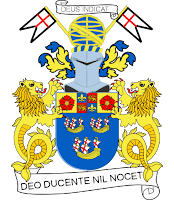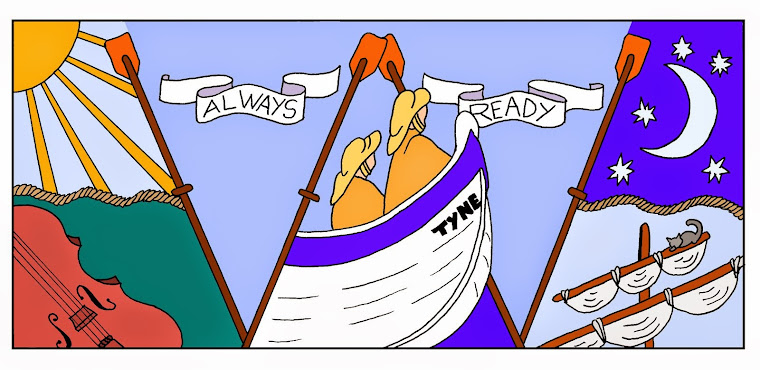The earliest mention of a Wouldhave family in London is
at Wapping, Middlesex; this is the baptism of Robert Wouldhave in 1674 and his
burial later that year. His parents,
Robert and Margaret Wouldhave already had a daughter Elizabeth who was born in
about 1671 and a son Joseph who died in 1677. It is possible that Robert was
living in North Shields before moving to Wapping. There is a baptism of
Elizabeth in 1669 at Christchurch, Tynemouth which may correspond.
Robert and Margaret had six further children baptised in
Wapping, of which only three survived childhood, John b 1675, Mary b 1679 and
Margaret b 1684. Robert was described as a mariner in parish records; in a
letter (which can be viewed at the British Library) from the East India Company
dated 20th February 1683 Robert was commissioned as Captain of the Syam
Merchant which set sail for the Bay of Bengal.
 |
| East India Company Arms 1600 - 1709 By DiegoAma - Own work, CC BY-SA 4.0 |
The letter warned of the
danger of pirates in the region of the Cape Verde Islands and that on the
journey back the ship should try to keep company with other ships for defence.
The letter also stated “We desire you to keep up the worship of God on Board
your ship and good order among your men and take care of their health”. Captain Wouldhave was also warned not to
trust anyone from other European nations since at that time they did not know
how England would stand in terms of relations with other countries when the
ship eventually returned to England. William Hedges Esq, agent and governor for
the East India Company noted meeting the Syam Merchant in his diary
while on his journey out to Bengal on February 26th 1684.
Robert died at sea in 1685 while on the voyage. He was
succeeded in the captaincy by the mate Francis Burrel, who brought the ship
safely back to London, presumably bearing the news of Robert’s death to his
widow Margaret. Margaret was granted Administration on 13th April
1686. Margaret was left with a young family to care for. Elizabeth, the eldest was 15 years, John 11
years, Mary 7 years and Margaret, the youngest, was 2 years old. There were
sufficient funds for Margaret to continue to live in the area and take care of
her children.
In 1687 Elizabeth married James Jenifer (b 1661 approx),
with permission from her mother, Margaret. James was a mariner and son of James
Jenifer snr who had been a naval captain who commanded the Queen’s yacht from
1671 until his death in 1677. Many naval captains were relatively poor; few
could make a living from their pay alone and a financially successful naval
career depended on prize-taking. The
Jenifers lived in a modest house in Deptford. For most naval sea captains, life
was a constant struggle to fend off creditors and claim the monies due to them
from the state. Information from Margaret Wouldhave’s will (1695) indicted that
she had already provided financial support to the couple since it stated “in
consideration of what I have already advanced and given unto my daughter
Elizabeth Jenifer wife of James Jenifer Mariner”
Margaret’s will showed her to be a wealthy widow. Her son
John inherited the family house. Her two unmarried daughters, Mary and
Margaret, were left the sum of seven hundred pounds to be shared among them
equally when they came of age or married. Elizabeth was also living in her
mother’s household or renting rooms from her since in Margaret’s will she was
left “the bed whereon she now lodgeth and all the furniture to the same
appertaining with the needlework looking glass now standing in the best chamber”
After Margaret’s death, James and Elizabeth Jenifer lived
in Whitechapel and they had a daughter called Sarah. James was also a mariner
with the East India Company. He was Commander of the ship Katherine on
its voyage to the East Indies when he died in 1706, at the age of about 47
years. In his will he left everything to
his wife Elizabeth who was also his sole Executor.
 |
| East India ship about 1690 |
 |
| Signature of Wouldhave Denn from his will 1747 |
Wouldhave left his estate to his
parents during their lifetimes but his father died before probate was
granted. Mary was the beneficiary and executor
of her husband’s will and obtained the probate of her son’s will also.
Wouldhave Denn’s will only mentioned his brothers John and Edward in his will
as well as his siters without mentioning how many had survived by this date.
Mary Denn died in 1749.
In her will she left houses in Wapping and Rotherhithe and as well as
bonds in the East India Company. Her son John was the major beneficiary together
with her daughters Mary, whose married name was Green, and Elizabeth, whose
married name was Drayton.
Margaret Wouldhave, the daughter of Margaret and Robert,
died in 1705. She had not yet come of
age so did not inherit from her mother’s will of 1605. Margaret left small bequests to each of her sisters
and some of her friends with “the residue to my niece and goddaughter
Margaret Denn daughter of my sister Mary at marriage or 21”
John Wouldhave may have also been a mariner. A Letter of Marque, dated 1697, for the ship Richardson
Galley, captained by Richard Ryder, lists John Wouldhave as Master. This
ship, with forty crew, was described as having food for 6 months and carried
twenty guns, twenty barrels of powder, sixteen rounds of great shot, 300 rounds
of small shot and forty small arms. The ship was sailing to South Barbary, i.e.
the coastal regions of North Africa. Letters of Marque were not to give
permission to carry weapons on a ship since that could be done without needing
any special permission. However, a Letter
of Marque allowed a ship to take a prize if the opportunity arose, without it being
labelled piracy. Unfortunately we have no further information on the Richardson
Galley and whether it was involved in any incidents of prize taking.
















